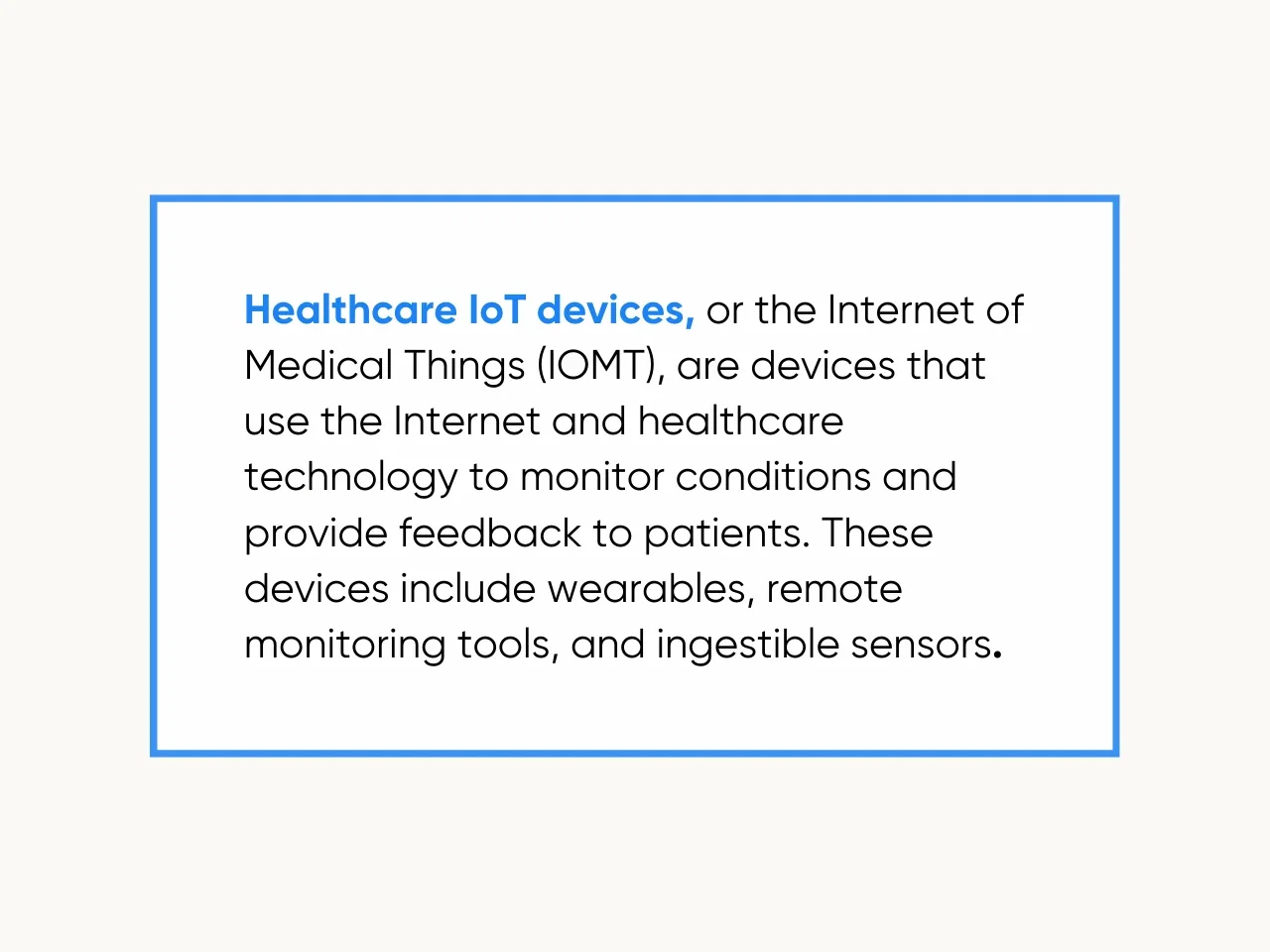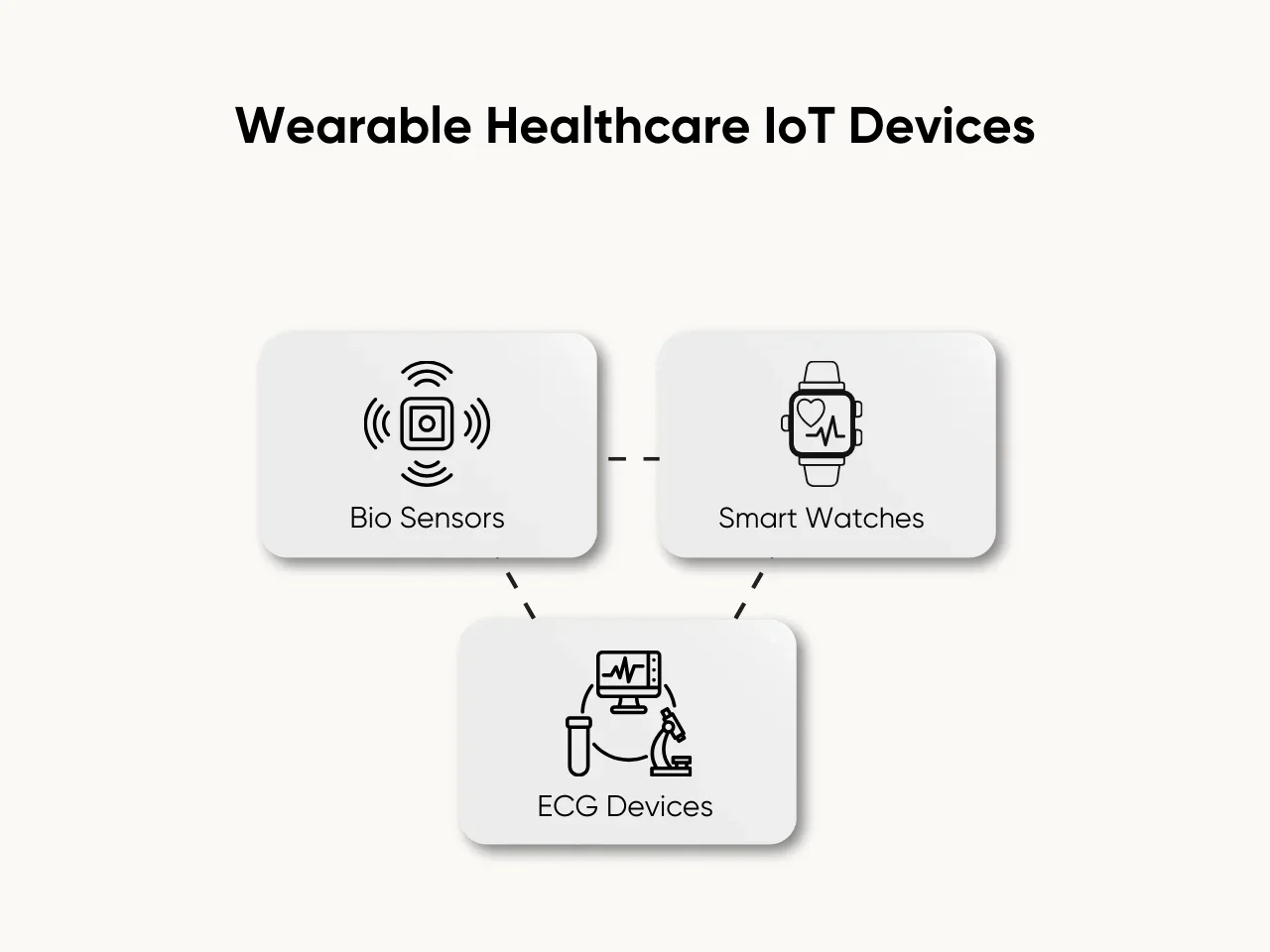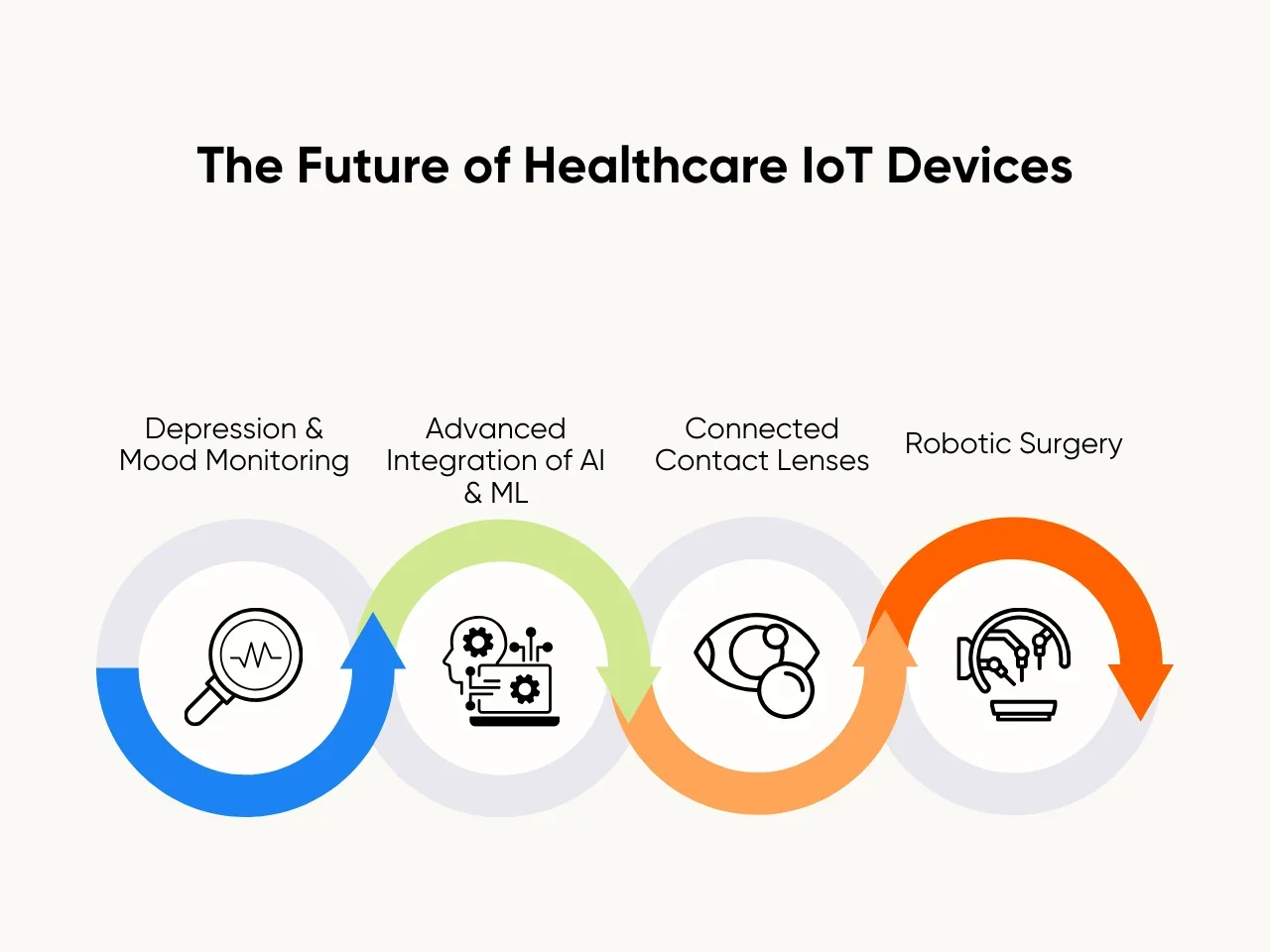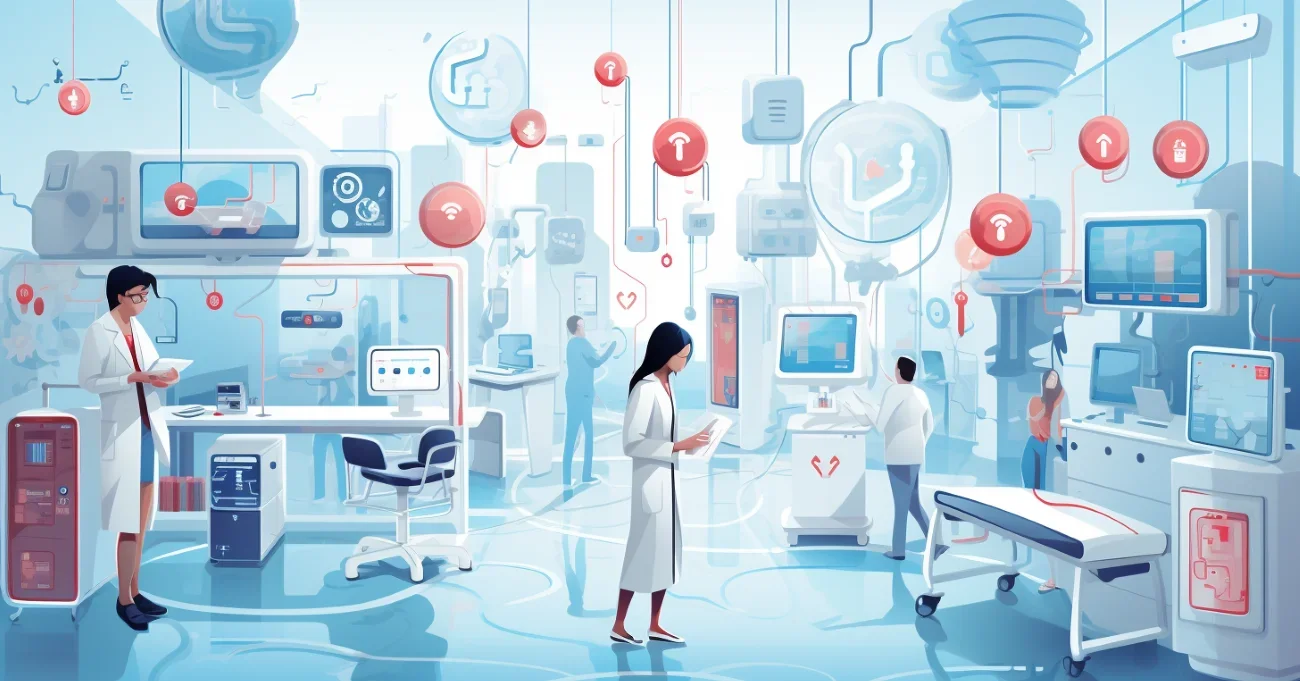Healthcare IoT devices are integral components in relaying patients' relevant information wirelessly using the Internet's online capabilities. Medical professionals use the Internet of Things (IoT) to transform patient care and data analytics into quicker and more accurate usable information while also being less restrictive than traditional field testing equipment.
Our team at Aloa highlights the progressive nature of software development and utilizes it with our partnered developers to craft new innovations and systems that can help improve the healthcare industry to new heights.
In this blog post, we will discuss some of the must-know innovations for healthcare IoT devices in 2024. We shall also talk about the implications and benefits of these software developments for the future of the medical industry.
Let's begin!
What are Healthcare IoT Devices?

Healthcare IoT devices, otherwise known as the Internet of Medical Things (IOMT), refer to devices that combine the widespread availability and functionality of the Internet with healthcare technology to monitor conditions and provide feedback to patients. These equipment can range from wearables to remote monitoring and even ingestible sensors.
IoTs are also being developed to function with artificial intelligence (AI) integration as well as machine learning (ML) capabilities to boost the impact in the healthcare industry further. Medical establishments can enable these devices to learn and adapt based on the results and readings to provide a more personalized healthcare solution.
IoT (Internet of Things) vs IoMT (Internet of Medical Things) Devices
Although IoTs and IoMTs have similar functionalities, key distinctions exist between both types of products. IoMTs focus on medical applications with a direct focus on improving healthcare-related benefits, including monitoring, feedback, and data transmission. The specialized focus on healthtech allows software developers to directly improve the health and wellness industry.
On the other hand, general-purpose IoTs can address multiple functionalities that may or may not include features related to medical or wellness aid. Popular examples of products categorized as IoT and IoMT are smart watches with some wellness functionalities, such as blood pressure monitoring. Still, they are not limited to those capabilities entirely. However, both categories utilize connectivity with the Internet to fully capitalize on its capabilities.
Types of Healthcare IoT Devices in the Healthcare Industry
Healthcare IoT devices can vary depending on the intended use and target user base. Some products are aimed at providing non-obstructive functionality. In contrast, others might require direct collaboration with medical professionals to ensure the equipment is carefully monitored for its intended use.
Here are some of the most common types of healthcare IoT devices in the healthcare industry today:

In-Home Healthcare IoT Devices
As the name suggests, in-home healthcare IoT devices are typically installed in a patient's workplace or residence to ensure that immediate care is provided for individuals. Individuals such as the elderly or those categorized as high-risk are the most common users targeted for in-home healthcare IoT device installation.
One example of an in-home healthcare IoT device is a personal emergency response system to indicate if a patient has fallen or suffered a critical injury and needs immediate support. These applications immediately notify a nearby hospital or clinic to send medical professionals to the location as soon as the device detects an emergency.
Wearable IoT Devices
Wearables, or on-body IoT devices, are products that directly connect to a user to provide immediate access for personal medical screening. This type of equipment enables individuals to effectively keep track of their health and wellness. It also automatically updates the medical record to a personal cloud to ensure all data is easily accessible.
Most common-grade wearable healthcare IoT devices are found in most smartphones or smartwatches, which allow users to get basic medical information such as their blood pressure with a single click of a button. On the other hand, healthcare establishments can install and monitor more serious medical-grade IoMT devices for patients needing cases such as mitigating pains in the nervous system.
Mobile IoT Devices
Similar to wearables, mobile IoT devices allow users to share their health and wellness recordings with specific medical professionals for updating measures. Healthcare industries can typically use this information to enable more accurate treatments without needing long-term testing as long as the patient relays the findings of their IoT devices directly to their doctors or healthcare providers.
Combining mobile IoT devices with advanced technologies such as near-field communication and RFID (Radio Frequency Identification) makes the process of sharing confidential personal data safer and more accessible for both patients and medical professionals.
Healthcare IoT Device for Health Monitoring
Health monitoring is as essential as providing quick and precise medical treatment. The development of healthcare IoT devices allows medical professionals to receive real-time updates on a patient's condition and detect anomalies as they appear. Leveraging these devices is integral for faster reactions in the healthcare industry.
These healthcare IoT devices are designed to assist with health monitoring directly.

Heart Rate Monitoring IoT Devices
Cardiovascular health is a serious component in ensuring a person can live long and healthy lives. With the ability of healthcare IoT devices to perform active heart rate monitoring, patients can remotely detect if there is an increase in irregular heart rhythms or other anomalies and provide immediate action as soon as it's detected.
Heart rate monitoring can also be prescribed by medical professionals to patients currently recovering from critical surgery to ensure that their cardiovascular conditions do not flatline during recovery. Healthcare industries can also utilize this type of IoT device to distinguish patients with a higher risk of potential heart failure.
Asthma Monitoring Devices
Managing asthma is a challenge for some patients, depending on the quality of lifestyle they live and the severity of the illness itself. Healthcare professionals must conduct extensive tests to determine the extent of a patient's asthma before they can provide an accurate diagnosis of their situation. However, asthma monitoring devices can shorten the time for both discovery and treatment.
Asthma-monitoring IoT devices track a user's lung flow and peak capacity and formulate a detailed analysis of the results throughout the day. The main benefit of these IoT devices is that they allow individuals suffering from this disease to remain proactive and receive critical information if their breathing patterns indicate a potential sign of an asthma attack, possibly preventing the condition from occurring or at least acclimating.
Remote Patient Monitoring Devices
Rest and recovery are critical components of any medical treatment. Post-surgery patients are the most at-risk individuals when it comes to maintaining their strength. Fortunately, remote patient monitoring devices allow healthcare professionals to track and manage a patient's medical condition without requiring constant in-person visitations or consultations.
Healthcare establishments can also utilize these types of IoT devices in their system to quickly monitor both in-house and at-home patients to ensure a wider and more informed reach. These devices enhance patient care by continuously monitoring vital health metrics, such as blood pressure, heart rate, and glucose levels. Reliable support services, such as medical courier services, also play a key role in this ecosystem by safely transporting lab samples, medical equipment, and time-sensitive materials that complement remote monitoring workflows.
Ingestible Sensors
A recently developed groundbreaking technology in modern health and wellness is the development of ingestible IoT sensors. This type of equipment will require patients to ingest the product, typically encased in a tablet or pill form. The sensors can then directly interact with the individual's vital organs, providing the most accurate analysis of their internal organs.
These ingestible sensors can track basic health metrics such as internal body temperature and glucose levels. At the same time, advanced data such as medical adherence for patients with specific allergies, stomach pH levels, and those that require frequent blood testing and monitoring can utilize this non-intrusive method much easier to handle and with longer lasting results.
Wearable Healthcare IoT Devices
Healthcare is also not relegated to medical-grade equipment. Regular individuals can also keep their health and wellness in check with the use of wearable healthcare IoT devices to ensure that they are still in optimal capacity. With a rising surge in popularity in recent years, access to these wearable healthcare IoT devices is easier than ever.
Here are some essential wearable healthcare IoT devices to watch for:

Bio Sensors
Biosensors are medical equipment that analyze biological data and provide real-time health information based on the findings. These products evolve to utilize IoT systems to enable patients to access relevant data regarding their results. Although a biosensor is more typically associated with invasive treatments, further development into this type of technology opens more non-invasive solutions for patients.
One of the main advantages of biosensors is their inexpensive and easily accessible nature, which allows both healthcare establishments and regular civilians to track and manage existing medical conditions. On the other hand, most biosensors are generally designed to seek out selective results specifically, which can require multiple different products to receive more thorough results.
Smart Watches
As previously mentioned, the rapid development of smart technology in modern technology allowed essential household items and wearables to come equipped with advanced health and wellness systems. Smartwatches are commonly installed with basic IoMT software, allowing users to gain insight into various health metrics such as heart rate, physical activity, and sleeping patterns.
These wearable healthcare IoT devices are a great solution for long-term monitoring for users interested in providing health and wellness data to distinguish specific anomalies in their daily lives. Integration with machine learning capabilities and artificial intelligence can even utilize a patient's medical data to provide better feedback on improving their lifestyle in one platform. FHIR implementation enhances this integration by standardizing the exchange of healthcare information, making it easier for these technologies to communicate effectively with existing healthcare systems.
ECG Devices
Cardiac monitoring and care are easier to handle with ECG IoT devices. Medical professionals can instruct their patients to wear a non-obtrusive and non-invasive ECG device that can help monitor the electrical activity of their heart. The results can provide valuable data that doctors can utilize to determine underlying cardiovascular conditions and prescribe effective treatment.
ECG devices are also instrumental in the detection of specific cardiovascular issues such as heart failure, acute coronary syndromes, and arrhythmias. Most ECG devices are closely supervised by a medical professional and should provide sufficient results after a full day of wearing the medical equipment.
The Future of Healthcare IoT Devices
With technology advancing at a staggering pace, the ways in which the healthcare industry tackles preventative diagnosis and medical treatments are drastically changing. Implementing healthcare IoT devices in modern medicine allows health and wellness professionals to gain accurate information on a patient's condition while improving their ability to provide better treatment.
These new developments allow both individuals and medical professionals to become more proactive with their health and wellness. That is why it's important to take a deep look into what the future of healthcare IoT devices has in store for the medical industry.
Here are some of the current healthcare IoT trends to watch closely in 2024:

Depression and Mood Monitoring
Mental health is as important as physical well-being. With more individuals striving to improve their mental states into something more positive, healthcare developers have been hard at work formulating "mood-aware" IoT devices to tackle personal issues such as anxiety and depression.
These healthcare IoT devices aim to provide better feedback for individuals who are experiencing large and frequent mood swings by analyzing different health metrics such as blood pressure, energy levels, and glucose levels, and, to more advanced systems, check the individual's movements to determine any glaring changes.
Advanced Integration of AI and ML
Both artificial intelligence and machine learning have seen massive improvements in their capabilities. With both systems allowing users to formulate advanced formulas based on the relevant data and information received by the system, integrating these metrics to provide better healthcare is an integral part of rapidly scaling faster medical care.
Connected contact lenses can also detect other types of illnesses outside of traditional eyesight issues, such as diabetes, by analyzing the glucose levels of a person's tears. If further developed, this functionality can potentially prevent the deterioration of sight completely as long as the system is managed correctly.
Connected Contact Lenses
A newly targeted system for improved eyecare is the development of connected contact lenses. These lenses are wearable similarly to traditional contacts but can provide information based on the quality of a user's eyesight. The challenge of humans naturally deteriorating their eyesight makes this type of healthcare IoT device a significant step in decreasing the chances of blindness and other types of diseases.
Connected contact lenses can also be used to detect other types of illnesses outside of traditional eyesight issues, such as diabetes, by analyzing the glucose levels of a person's tears. This functionality, if further developed, can potentially lead to preventing the deterioration of sight completely as long as the system is managed correctly.
Robotic Surgery
Robots can be utilized appropriately to aid people in performing many tasks while minimizing the potential risks typically associated with human error. Modern medical industries are developing Internet-connected robots inserted into the human body to perform accurate surgeries, specifically on critical injuries such as blood clots or hairline fractures.
These robotic healthcare IoT devices not only reduce the risk of human error but can also provide more accurate surgical procedures, such as utilizing only the minimal incision length required. Further integration with AI can also help by actively analyzing the patient's internal organs and condition while conducting the operation simultaneously.
Key Takeaway
Healthcare IoT devices provide quick and precise medical data that both regular individuals and medical professionals can utilize to help manage existing medical conditions. The ease of integrating these systems into various health and wellness products can further prolong the viability of a person's physical and mental states while allowing for non-obtrusive for better medical care.
Most IoT devices are integrating features from IoMTs to allow users to take advantage of common products such as smartphones and smartwatches to monitor their health and wellness while providing relevant feedback and maintenance through the use of artificial intelligence.
If you want to learn more about how IoT devices function, contact us at [email protected] to learn more.

